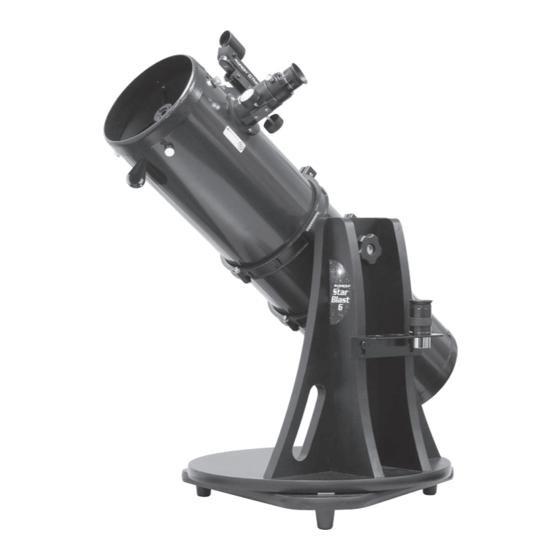
Table of Contents
Advertisement
Quick Links
Advertisement
Table of Contents

Subscribe to Our Youtube Channel
Summary of Contents for Orion STARBLAST 6 9964
- Page 1 Manual orion StarBlast 6 ® astro telescope #9964 Customer Support (800) 676-1343 E-mail: support@telescope.com Corporate Offices (831) 763-7000 Providing Exceptional Consumer Optical Products Since 1975 89 Hangar Way, Watsonville, CA 95076 IN 330 Rev. A 02/08...
- Page 2 Congratulations on your purchase of an Orion StarBlast 6 Astro Telescope. Our new StarBlast 6 is easy to use and requires very little assembly. The StarBlast 6 will give you breathtaking views of the Moon, planets, and even deep-sky objects like the Orion Nebula.
- Page 3 This is explained in the Collimating appendix. Altazimuth base: This wooden base provides a stable base for the telescope. It allows you to move the tele- scope in altitude (up/down) and azimuth (left/right). Carrying handles: These convenient handles are built into the base, allowing you to easily carry the StarBlast 6 to your viewing location.
-
Page 4: Getting Started
You can place the 10mm Sirius Plössl eyepiece (12) in the eyepiece rack (11) for use later. Your telescope is now fully assembled. Remove the dust cap from the front of the telescope when it is in use. Replace it when you are finished observing. getting Started It’s best to get a feel for the basic functions of the StarBlast... -
Page 5: Focusing The Telescope
(left/right). Simply take hold of the navigation knob (7) and move it left or right so that the base rotates. Move the telescope tube up or down in the same manner. Both motions can be made simultaneously and in a continuous manner for easy aiming. -
Page 6: Using Your Telescope
Alignment of the EZ Finder II is easiest during daylight, before observing at night. Aim the telescope at a distant object at least 1/4 mile away, such as a telephone pole or chimney and center it in the telescope’s eyepiece. - Page 7 Faint deep sky objects become difficult or impossible to see through the murk of light pollution. Even bright nebulas like the Orion and Lagoon Nebulas lose much of their delicate detail. The Moon and planets are not affected; they require steady air more than dark skies, so they remain good targets for city-dwelling observers.
- Page 8 Each ses- sion with your telescope will be a learning experience. Each time you work with your telescope it will get easier to use, and stellar objects will become easier to find. There is big...
-
Page 9: Care And Maintenance
OK. Small components like eyepieces and filters should be kept in a protective box or storage case. Keep the dust caps on the front of the telescope and on the focuser when it is not in use. The telescope requires very little mechanical maintenance. -
Page 10: Appendix A: Collimating (Aligning The Mirrors)
The secondary mirror itself should be centered in the focuser drawtube, in the direction parallel to the length of the telescope. If it isn’t, as in Figure 10b, it must be adjusted. This adjustment will rarely, if ever need to be done. -
Page 11: Aligning The Primary Mirror
Figure 11. To center the secondary mirror under the focuser, hold the secondary mirror holder in place with your fingers while adjusting the center screw with a Phillips head screwdriver. Do not touch the mirror’s surface. Now tighten the three small alignment screws equally to secure the secondary mirror in that position. -
Page 12: Appendix B: Cleaning The Optics
During this warranty period Orion Telescopes & Binoculars will repair or replace, at Orion’s option, any warranted instrument that proves to be defective, provided it is returned postage paid to: Orion Warranty Repair, 89 Hangar Way, Watsonville, CA 95076. Proof of pur- chase (such as a copy of the original receipt) is required.









Need help?
Do you have a question about the STARBLAST 6 9964 and is the answer not in the manual?
Questions and answers